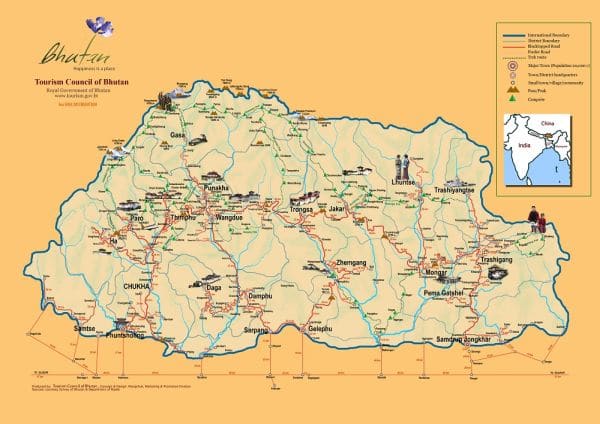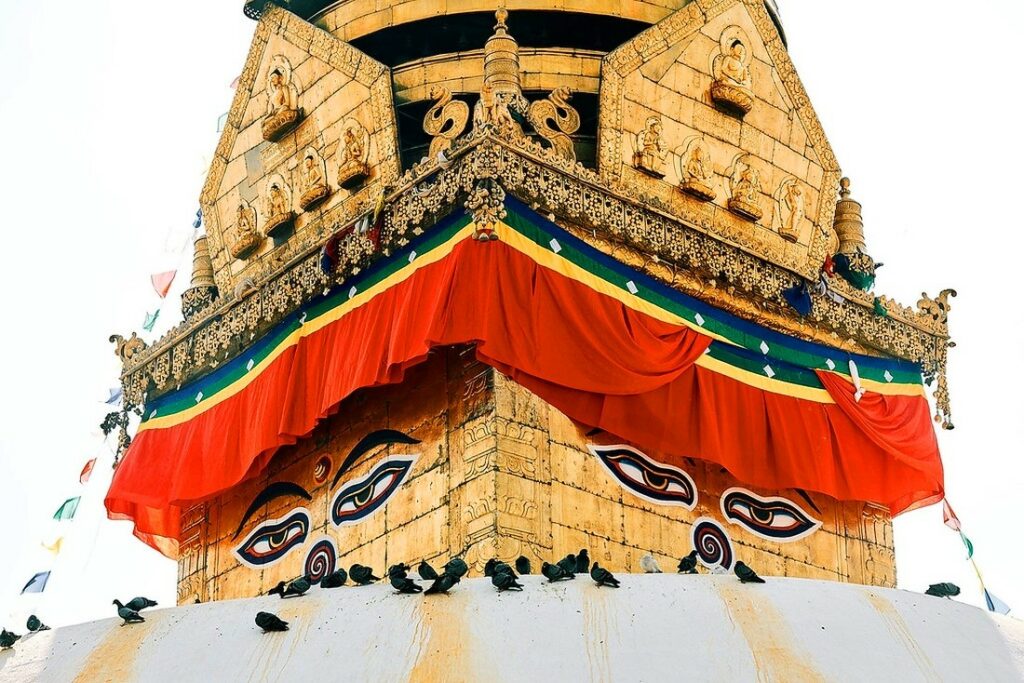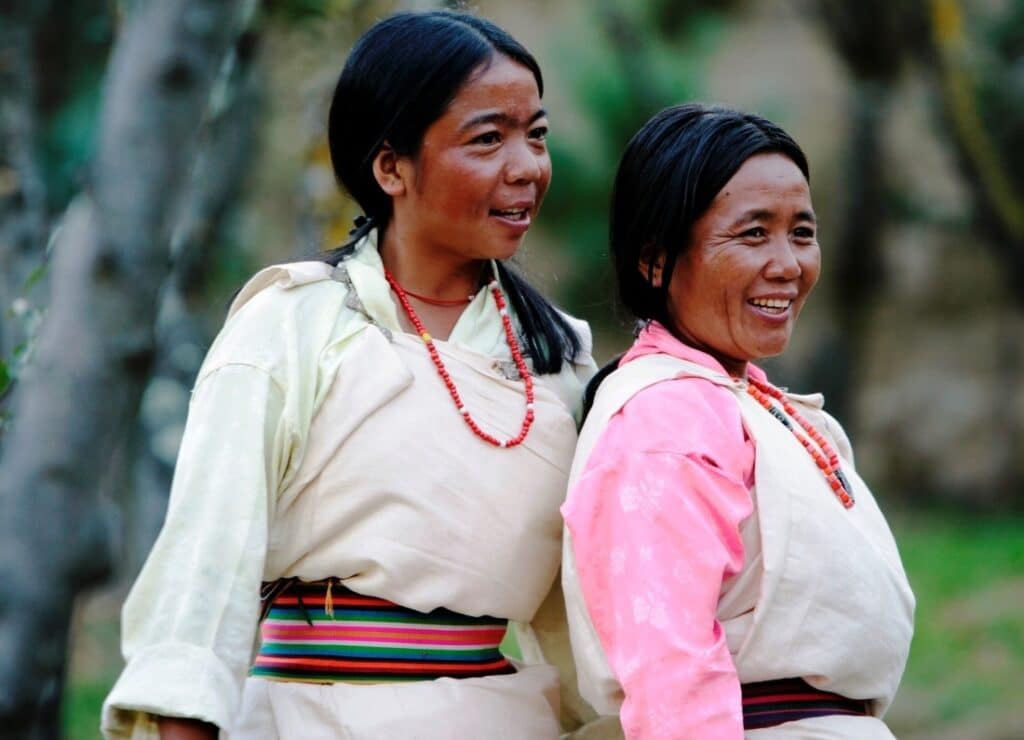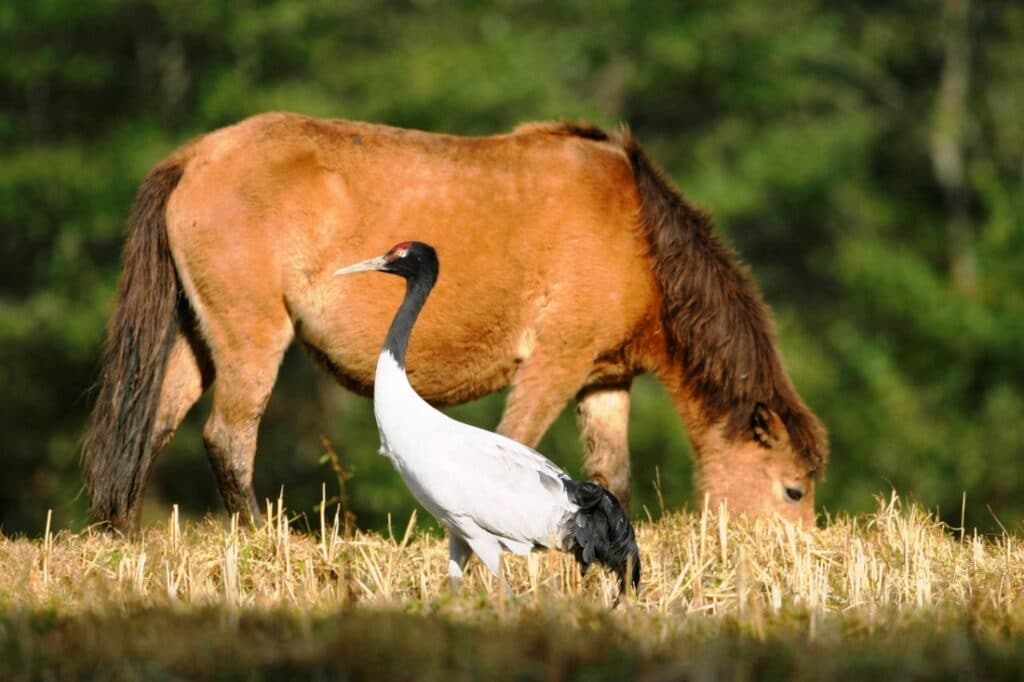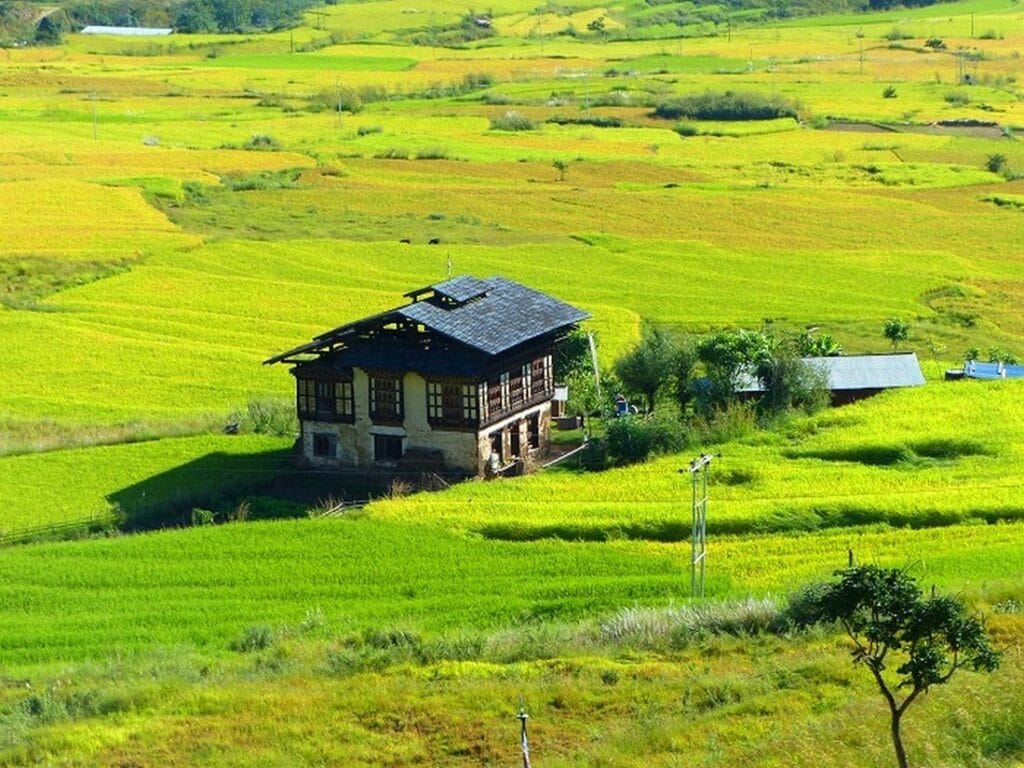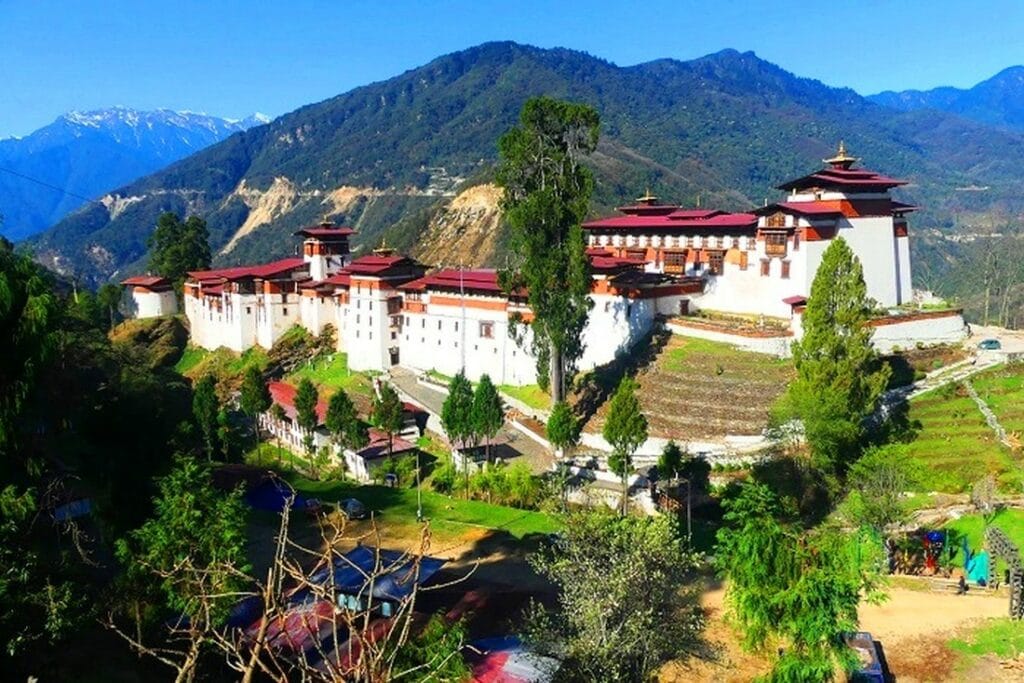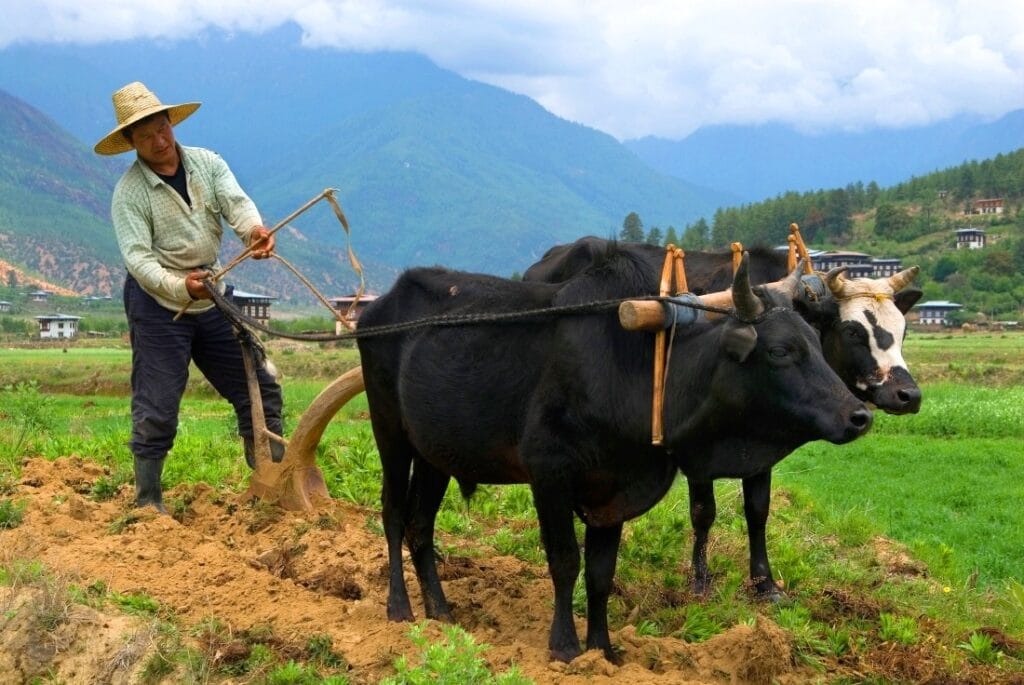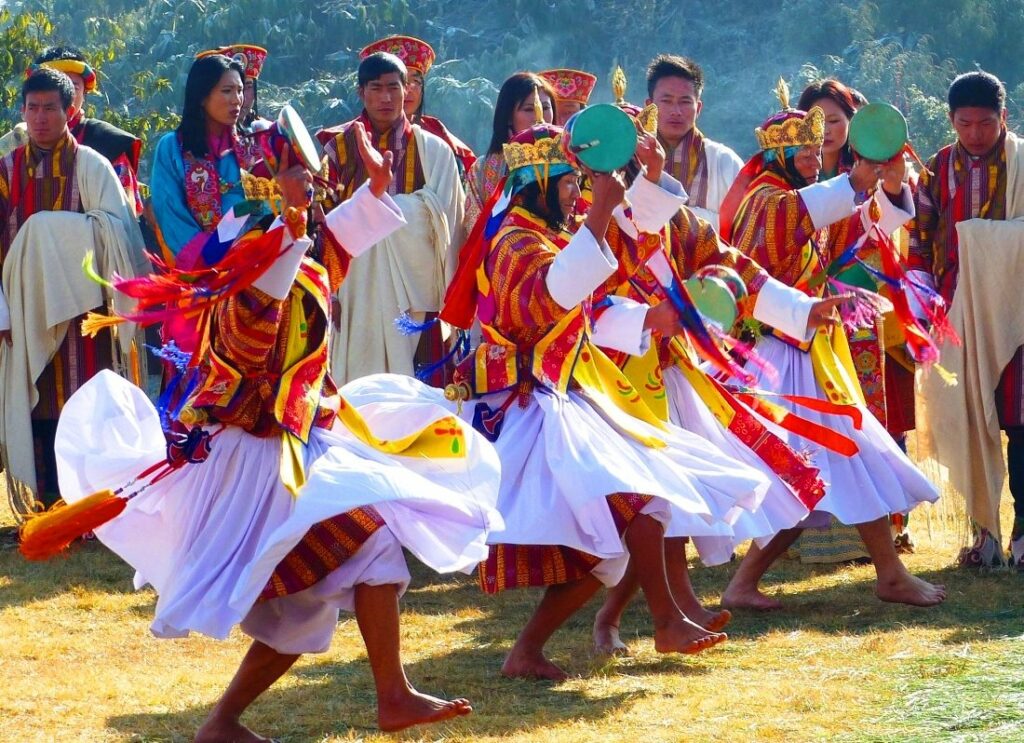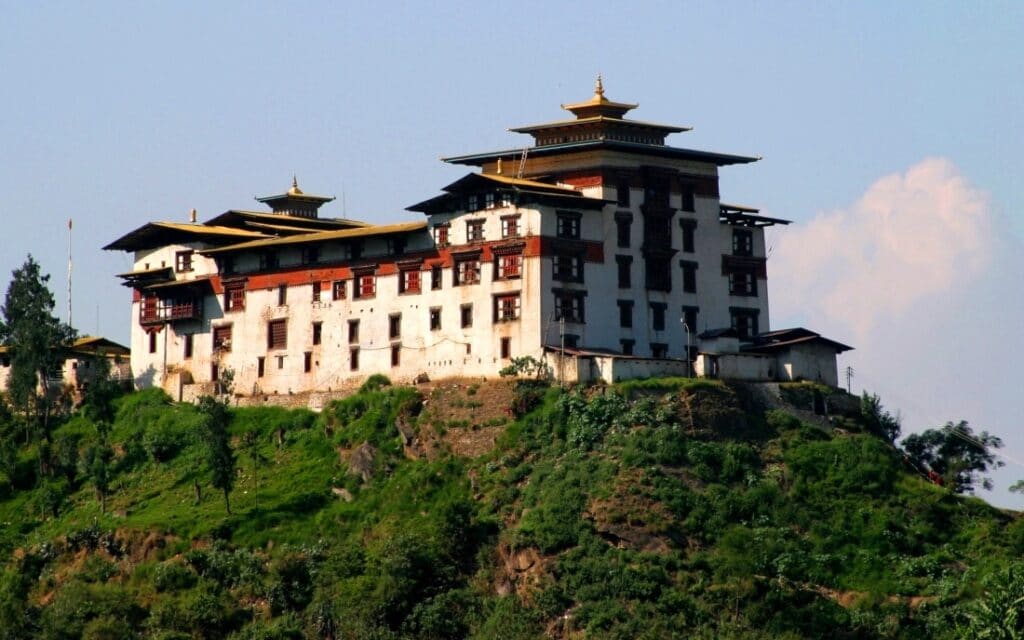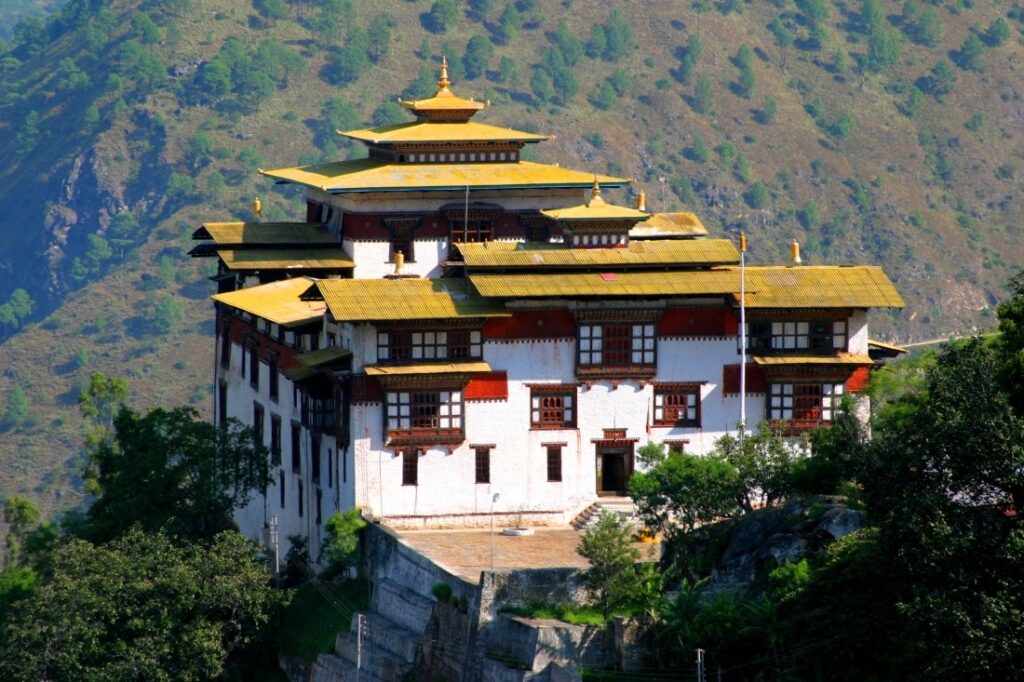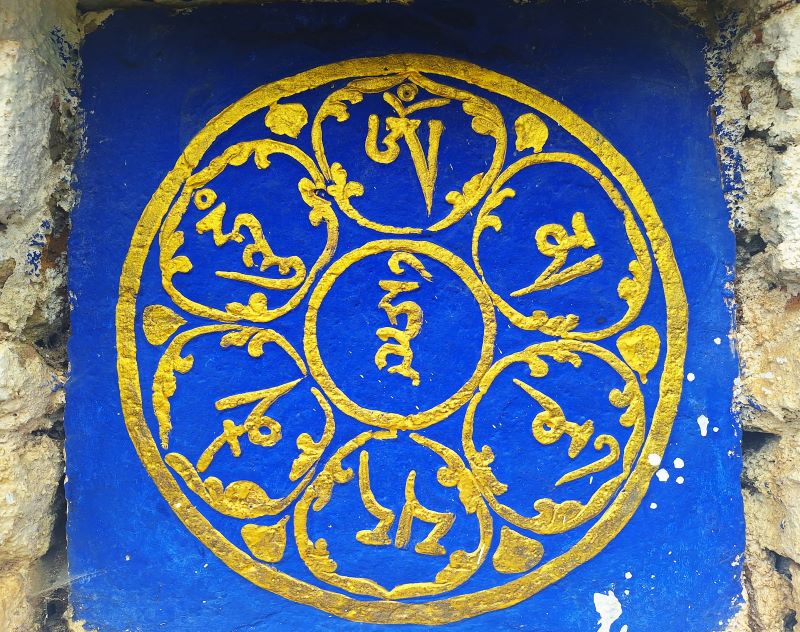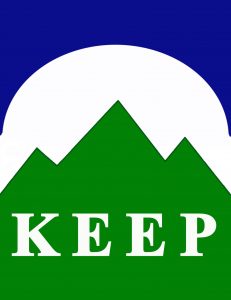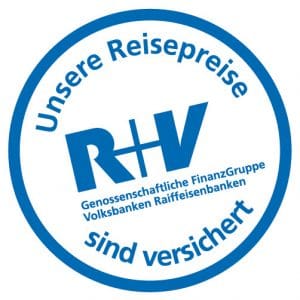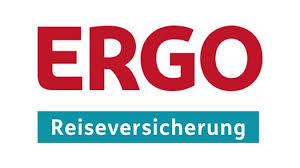Crossing Bhutan – from west to the wild east
- Description
- Gallery
- Trip itenerary
- Trip dates, prices and services
- Important travel information
- Request Book
Bhutan – the land of happy people to cross from west to east is a special journey. The ascent through a fairy-tale forest to the legendary “Tiger’s Nest”, is one of the most beautiful highlights of this tour.
When crossing the Dochu-La Pass you have a spectacular view of the fantastic mountains of the Himalayas. On a clear day, you can see the 7000s mountain range that separates Bhutan from Tibet. The imposing 17th-century Punakha Dzong is picturesquely situated at the confluence of the two rivers Pho and Mo and reveals the fantastic handicrafts of Bhutan. The untouched nature creates a unique flora and fauna in Bhutan, which you can marvel at on smaller hikes. In winter, dreamy sites are the refuge of the rare black-necked crane. Your journey continues over high passes and valleys, past mighty dzongs and monasteries.
In East Bhutan, the land of the thunder dragon, you come into contact with a very important part of the kingdom. They experience a genuine culture that is unique in its architecture, clothing and religion. They meet the indigenous people who still have their own language in the remote valleys. The landscape in the east is rougher, steeper and pristine than the rest of Bhutan.
The tour schedule will be adapted to the festivals.
Day 1: Arrival in Kathmandu – Introduction to the trip and welcome dinner
You will be picked up at the airport and driven to your hotel. In the afternoon we will discuss the details of the tour, and in the evening you are invited to the welcome dinner, where you can enjoy the excellent Nepalese cuisine. Overnight in Hotel Tibet or similar category, (B).
Day 2: Sightseeing in Kathmandu
Today you will explore Kathmandu with a local guide. The most popular places are the Buddhist / Hindu temple Swayambhunath, which is also called the monkey temple, is reached via a long staircase and offers great views of Kathmandu. Other important sights are the Hindu temple complex of Pashupatinath located on the banks of the Bagmati River, with cremation sites, and the holy Buddhist Boudhanath Stupa which is decorated with colorful prayer flags. This stupa has been a magnet for Buddhist pilgrims for many centuries, who repeatedly circled the structure, turning prayer wheels, praying and mumbling mantras (kora). Overnight in Hotel Tibet or similar, (B).
Day 3: Transfer to Kathmandu Airport for the flight to Paro
The flight to Paro is one of the most spectacular mountain flights in the world and offers panoramic views of some of the highest mountains on earth. After landing and completing the visa formalities, there is a 20-minute drive to Paro (2,200m) and check-in at the hotel. From here we walk to Paro Dzong while we also cross a cantilever bridge. Then we visit the Kyichu Temple, which was probably built in the 7th century, and go back to our hotel. Free time in the evening. Overnight at Hotel Paro, (B|L|D).
Day 4: Day hike to Tiger’s Nest
Today we hike up to Tiger’s Nest. The most famous and holiest monastery in Bhutan was recently registered as one of the holiest places in the world. It is enthroned at about 3,100 meters above the Paro valley and is known as the tiger’s nest because the legendary guru Rimpoche allegedly flew to this place on the back of a tigress in the 8th century. The five-hour walk to the monastery is an intense but rewarding mountain tour with an ascent of over 900 meters. He cleanses the soul and the body alike. In the late afternoon there is the opportunity to visit a traditional farmhouse to learn more about the life of the people in Bhutan. Overnight at Hotel Paro, (B|L|D).
Day 5: Drive Paro to Thimphu approx. 1 ½ hours drive
After breakfast we drive from Paro to Thimphu. An estimated 120,000 people live in the modern capital of Bhutan. After lunch in the hotel, we visit a memorial site that commemorates the third king Jigme Dorji Wangchuk, who is considered the father of modern Bhutan, and the Tashichho Dzong, which was built in the mid-17th century. This fortress serves as the official residence of the king, ministers and various government organizations. Free time in the evening to walk through the town of Thimphu. Overnight at Hotel Thimphu, (B|L|D).
Day 6: Sightseeing in Thimphu – astrology school, mini zoo, Buddha Point
We are going to the north of Thimphu. The first stop brings us to the astrology school. Then we continue north to Dodena to visit the mini zoo and observe the national animal “Takine”. We return to Thimphu for lunch. Then we undertake an easy hike (about 1.5 hours) through a pine forest to the Wanduetse temple. From here you have a wonderful view of the Thimphu Valley. Another beautiful view awaits you from Buddha-Point / Kuenselphodrang (2,600 m). The 52 meter high Buddha statue has become a landmark of Thimphu city in recent years. Overnight at the hotel in Thimphu, (B|L|D).
Day 7: Thimphu to Punakha (71km, approx. 3 hours drive) – Dochula Pass and visit to the Mad Man`s Temple
After breakfast we drive to the Punakha Valley (1,220m). Punakha functioned as the capital of Bhutan until 1955 and is now the winter residence of the central monks’ association. On the way we will stop at Do Chula Pass at 3,150 meters to marvel at the 108 chortens built on three levels. With a little luck and in good weather conditions we will be able to see the main Himalayan ridge from there. The Gangkar Puensum – the world’s highest unclimbed mountain – should also be visible when the visibility is good. In Messina we will have lunch. Afterwards, a visit to the Mad Man‘s Temple (Chimi Lhakang) is on the daily program. The temple, built in 1499, stands in the middle of the valley on a small hill. It was dedicated to the Lama Drukpa Kunley (1455-1529), also known as “Divine Madman”, who became famous for his humor, his songs and also for his outrageous behavior. Childless couples who pray at this temple are said to find happiness afterwards.
In Punakha we will first check into our hotel and have the afternoon at leisure. There are various activities such as archery, learning to cook Bhutanese and / or taking a hot stone bath (typical type of steam bath). Overnight at the hotel in Punakha, (B|L|D).
Day 8: Punakha – Punakha Dzong and Sangcheen Dorji Lhendrup Nunnery
In the former fortress capital of Bhutan we cross the suspension bridge and after a short and easy walk we reach the historic monastery-castle Punakha Dzong. This impressive structure was built in 1637 by Zhabdrung Ngawang Namgyal at the confluence of the Mo Chu (female river) and Pho Chu (male river), was the seat of government for a long time and is closely linked to the historical traditions of Bhutan. Traditionally, the head of the Bhutanese clergy leaves his summer residence in Thimpu to spend the winter months in this dzong with his entourage due to the milder climate. The fifth king held his marriage ceremony here. After the visit, we will cross the longest suspension bridge over the Pho Chu River. Afterwards we drive to Talo and visit the nunnery Sangcheen Dorji Lhendrup. This monastery is located on a hill and offers an impressive 360 degree view over several valleys. Overnight at the Hotel Meripuensum, (B|L|D).
Day 9: Punakha to Trongsa (55 km, 3-4 hours drive)
After breakfast we walk to Khamsum Yulley Namgyal Chorten. This chorten was built to eliminate negative forces and symbolizes peace, stability and harmony in a rapidly changing world. We can enjoy breath-taking views of the valley from Chorten, which dominates the upper Punakha valley. Afterwards we drive about 3 hours to Trongsa and can then visit the special monastery castle Trongsa Dzong. Overnight in the hotel, (B|L|D).
Day 10: Trongsa – Bumthang (75 km, 3-4 hours drive)
Today we continue to Bumthang. The 75-kilometer route takes us over the picturesque Yotong La Pass and down into the Chhume Valley, home of Bhutan’s famous Yatra weaving mills. The afternoon is then at leisure. Overnight at Hotel Ugyen Ling, (B|L|D).
Day 11: Sightseeing in Bhumtang – palaces, monasteries
We start the day exploring the Wangdichhoeling Palace. Afterwards we visit Jambay Lhakhang, one of the oldest monasteries in the country. Then we walk to Kurjey Lhakhang, which is considered Bhutan’s most valuable monument. Guru Rimpoche is said to have meditated here and left traces. The early winter festivities are held in Kurjey Lhakhang and thousands of Bhutanese receive their blessings there. From here we hike back to Tamshing Monastery. So today we have lived up to a Bhutanese tradition that says that you should visit these three monasteries in one day. Overnight at Hotel Ugyen Ling, (B|L|D).
Day 12: Sightseeing in Bumthang Valley – Tang Valley, Burning Lake
Today’s destination is the beautiful Tang Valley. Before we reach the valley, we will stop at Membar Tsho or Burning Lake. According to tradition, the treasure hunter Terton Pema Lingpa is said to have recovered a treasure from this river in the 15th century. Only a few visitors are out and about in the Tang Valley. Various well-trodden paths lead to Lhakhang with its monasteries and to a museum in the Ogen Chholing Palace. A short hike ends at another well-tended palace, which houses many valuable artifacts. Enjoy a picnic with a spectacular view on the way back to Bumthang. Overnight at the Hotel Ugyen Ling, (B|L|D).
Day 13: Drive Bumthang to Mongar – 8 hours
After breakfast we drive to the village of Ura, visit Ura Lhakhang and then continue to Mongar, over the Thrumshingla pass (at 3,750 m the highest pass on the east-west road. A picnic lunch is served on the way. We now reach the east Bhutans, which differs in development and lifestyle from western and central Bhutan. The region is characterized by steep slopes and rushing waterfalls. On clear days we will have spectacular views of the Himalayan mountains. We continue to Mongar and explore a walk through the village, overnight in the hotel, (B|L|D).
Day 14: Drive from Mongar to Lhuntse and back to Mongar – 4 hours drive
Lhuntse Street winds around the hill to Chali and passes the few houses of Palangphu. The district is famous for the art and skills of its weavers. It is also the ancestral home of the Jigme Namgyel royal family. The father of the first king of Bhutan was born in the village of Dungkhar in Lhuntse. Lhuntse Dzong overlooks the Kuri Chuu Valley and is perched on rocky fields. We visit the Lhuntse Dzong and on the way we will have lunch. In the afternoon we drive back to Mongar. Overnight in the hotel, (B|L|D).
Day 15: Drive from Mongar to Trashigang – 92km and about 4 hours drive
Trashigang is 92 kilometers from Mongar, the drive by car takes about four hours and can be a bit bumpy. There we visit one of the largest dzong fortresses in Bhutan, the Trashigang Dzong (literally “The Fortress of the Hill of Fortune”), which was built in 1659 on a ledge with steep cliffs on three sides and overlooks the Drangme Chhu and Gamri Chhu rivers. The fortress was built to defend against Tibetan invaders. The dzong was home to a monastic community and has long been the central administrative center of the Trashigang district. Overnight at Hotel Trashigang, (B|L|D).
Day 16: Day trip to Trashi Yangtse – about 4 hours drive
53 kilometers from Trashigang is the beautiful Trashi Yangtse Valley. We visit Trashi Yangtse, a small, pretty and quiet place. The people are known for making wooden bowls and containers that are said to be the best in Bhutan. The Chorten Kora is located directly below the city. On the way to Trashi Yangtse we stop at the Gom Kora Temple, behind which there is a large black rock. Legend has it that Guru Rimpoche meditated in the rock cave and that you can see the imprint of his body, hat and that of a dragon crushed in battle on the rock. Chorten Kora is another attraction of this valley in eastern Bhutan. It is a great chorten from 1740, modeled after the style of the Boudhanath Stupa in Nepal. Numerous Bhutanese men and women make pilgrimages to Chorten Kora for the annual tshechu (religious festival). Return to Trashigang and overnight at Hotel Trashigang, (B|L|D).
Day 17: Drive from Trashigang to Samdrup Jongkhar – 6 to 7 hours drive
Today’s trip takes you on a winding road through several villages and a weaving center. If there is enough time, we have the opportunity to visit the school for the blind in Khaling. After about 7 hours and 180km drive we reach Samdrup Jongkhar, the border town to the Indian state of Assam. Overnight at Hotel Samdrup Jongkhar, (B|L|D).
Day 18: Drive from Samdrup Jongkhar to Guwahati – approx. 3 hours drive, and 110km and return flight home
It’s time to say goodbye to Bhutan.
We leave Bhutan in the direction of Guwahati (Assam / India) in order to arrive at the airport in Guwahati in time, so that you can reach your return flight home in time, (B).
You will organize the return flight from Guwahati to your home. On request, we will be happy to help you book the right flight.
We reserve the right to change the program due to special events, force majeure or weather conditions.
B = Breakfast | L = Lunch | D = Dinner
Price and Trip Date
German guided tour
English guided tour
-
06. October 2024 -
23. October 20244.490 € Request non-bindingBook bindingly
-
13. October 2024 -
30. October 20244.490 € Request non-bindingBook bindingly
-
20. October 2024 -
06. November 20244.490 € Request non-bindingBook bindingly
-
01. November 2024 -
18. November 2024
Black Necked Crane Festival4.490 € Request non-bindingBook bindingly
-
10. November 2024 -
27. November 20244.490 € Request non-bindingBook bindingly
-
24. November 2024 -
11. December 20244.490 € Request non-bindingBook bindingly
-
06. March 2025 -
23. March 2025
Punakha Tshechu4.490 € Request non-bindingBook bindingly
-
21. March 2025 -
07. April 20254.490 € Request non-bindingBook bindingly
-
31. March 2025 -
17. April 2025
Talo Tshechu in Punakha4.490 € Request non-bindingBook bindingly
-
04. April 2025 -
21. April 2025
Paro Tshechu4.490 € Request non-bindingBook bindingly
-
12. April 2025 -
29. April 20254.490 € Request non-bindingBook bindingly
-
28. April 2025 -
15. May 2025
Domkhar Tshechu in Bumthang4.490 € Request non-bindingBook bindingly
-
16. May 2025 -
02. June 20254.490 € Request non-bindingBook bindingly
-
01. October 2025 -
18. October 2025
Gangtey Tshechu4.490 € Request non-bindingBook bindingly
-
10. October 2025 -
27. October 20254.490 € Request non-bindingBook bindingly
-
20. October 2025 -
06. November 2025
Jakar Tshechu in Bumthang4.490 € Request non-bindingBook bindingly
-
07. November 2025 -
24. November 20254.490 € Request non-bindingBook bindingly
-
14. November 2025 -
01. December 20254.490 € Request non-bindingBook bindingly
Download Festival overview of 2024 and 2025
This trekking tour can also be booked for your individual group at an additional cost at dates other than shown here.
Duration: 18 days
Costs: 4.990€ per Person
Group size: min. 2 Persons (all the tour dates are guaranteed with a minimum group size of only two persons)
€ 590 for single room supplement
What’s included:
- Airport transfers in Bhutan and Nepal
- Flight from Kathmandu to Paro
- All relevant surface transfer
- All hotel accommodation with breakfast in Nepal
- All meals in Bhutan (B,L,D)
- Sightseeing with entrance fees, guide and vehicle
- Permit, National Park Entrance/Conservation Fees
- Guide & Driver
- Tourist fee per day and person, in Bhutan
- Quality service
Not Included:
- International Flights
- Additional tours and meals that are not mentioned
- Beverages
- Personal bills
- Visa Nepal (approx. US$ 50) and Visa Bhutan (US$ 40)
- Excess baggage charge (beyond 20 Kg each)
- Insurance (for cancellation, accident, health, emergency evacuation and loss, theft of or damage to baggage and personal effects)
- Tips
Visa
Visa fees for Nepal and Bhutan are not included in the price and will be paid in the airport at arrival in Kathmandu/Paro. Two passport size photographs must be provided for the visa. At the time of the trip your passport must be valid for at least a further six months and have at least two blank pages.
These visa and passport regulations apply to EU countries, Switzerland and the USA. Other nationals should check with the relevant consular authorities.
Vaccinations
There are no vaccinations required for traveling to Bhutan at this time. However, you should be vaccinated against COVID-19, tetanus, hepatitis A and diphtheria. We recommend you consult your GP (general practitioner) in good time, about three months before your trip.
Insurance
We highly recommend the conclusion of travel cancellation insurance. In the case of bargain price flights in particular, changes or cancellations generally can’t be made free of charge.
We have requested ERGO (Reiseversicherung) to create various service packages for you. You can book travel cancellation insurance at www.reiseversicherung.de.
Please note: ERGO insurance can be booked by residents of Germany and Austria. Those living in other countries are requested to book their travel insurance through an insurance provider in their own country.
It should be noted that geoDiscovery Tours advises its customers to book their travel insurance via ERGO as a recommendation only, and accepts no responsibility for the contractual content between the customer and the travel insurance provider. Customers can book their travel insurance via ERGO or another provider at their own discretion.
Flying in Bhutan and Nepal
The flights booked by us, between Nepal and Bhutan are with Bhutan Air or Druk Air. The domestic flights in Nepal booked by us are with Tara Air, Yeti Air, Sita Air, Summit Air or Buddha.
The hotels and lodges booked by us
In Nepal and Bhutan the hotels we book are good and correspond to medium-level Western standards. Sanitary facilities are clean and functional; the hotel cuisine is adapted to Western eating habits and the food is safe to enjoy. In Nepal, there may sometimes be power cuts or no hot water available for a while. The hotel staff is generally very friendly and looks after the welfare of guests. The hotels booked by us are as follows:
In Bhutan
Thimphu: Hotel Phuntsho Pelri
Phobikha: Hotel Dewachen
Bumthang: Hotel Ugyen Ling
Punakha: Meri Puensum Resort
Paro: Tashi Namgay Resort
In Nepal
Kathmandu: Hotel Tibet/Manaslu ***+
Pokhara: Mount Kailash Resort, Lake side retreat ***
Lumbini: Hotel New Crystal ***
Chitwan: Jungle Villa Resort
Nagarkot: Nagarkot Farmhouse
Tour program
The travel program for all of our recommended tours is carefully planned. It can happen, however, that roads are closed without advance notice or are impassable, that there are waiting times of several hours because of traffic congestion or fuel shortages and that specific tourist attractions are closed for various reasons. Other restrictions such as flight delays or even cancellations due to bad weather, strikes or the health of participants may also make the implementation of the travel program more difficult or at worst make it impossible. However, our local guides are prepared for such situations and will make every effort to achieve every aspect of the program to your satisfaction. As a result the inconvenience can normally be kept to a reasonable level. Nevertheless, it must be pointed out at this juncture that for the above reasons program changes are possible at any time and cannot be influenced by the organizers. The resulting costs are borne by the traveler. We ask for your understanding.
Road Situation
Despite high mountains, steep slopes, and the deepest of valleys Bhutan has a relatively well developed network of roads. It is difficult to find a length of either straight or flat road. In some stretches one can encounter 6 to 7 bends per kilometer! Steep ascents and descents are characteristic of road travel in Bhutan and this can make traveling much slower than one may be used to. The average driving speed is 40 km per hour. Travelers need to be adaptable, however.
Trip Details
- Duration: 18 days
- Holiday Type: Hotel Accommodation
- Best trekking period: Oct/Nov/Dec/Feb/Mar/Apr/May
- Difficulty: Gentle
- Max Altitude: 3.500 m
- Group size: Min. 2 persons (all the tour dates are guaranteed with a minimum group size of only two persons)
- Tour guide: English speaking, trained Bhutanese guide
-
Difficulty:
-
Fitness:
- Price: 4.490,00 €
- Single room supplement: 520,00 €

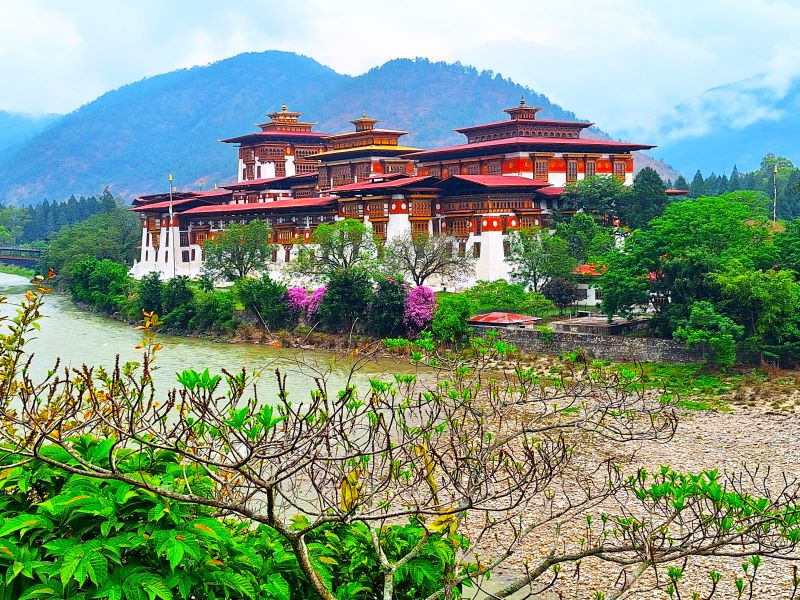
 Bhutan
Bhutan 